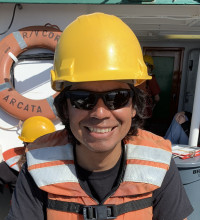Sandy beaches and surf zones are intensely used for recreation and are vitally important to California’s coastal economies. These dynamic ecosystems at the boundary of land and sea also support a diversity of animals, including fish, invertebrates, and birds. Harvested species of surf zone fish may benefit directly from MPAs. Beaches are also ecologically linked to nearshore kelp forests and shallow rocky reefs, that provide drift algae that fuels beach food webs. This means MPAs may help beach ecosystems through positive effects on adjacent kelp forests and reefs.
To evaluate responses of these understudied beach and surf zone ecosystems to MPAs, researchers surveyed surf zone fish, birds, stranded kelp, human use, surf zone and beach characteristics at pairs of MPA and carefully matched reference sites. Beaches and surf zones are not included in long term ecological monitoring programs, and the team's 154 surveys of surf zone fish using beach seines and video cameras were the first ever statewide comparisons. Surf zone fish overall and recreationally targeted fish species were more numerous in MPAs compared to reference beaches in video results, as was overall diversity. Combined biomass of these fish groups caught in seines was also greater in MPAs. The 252 surveys of beach birds, kelp plants and wrack found less evidence of responses to MPAs. However, peak numbers of shorebirds were found in MPAs suggesting some MPAs are hotspots with high conservation value for these ecological indicators. The project team recommends that long-term-monitoring programs are established for surf zone fish, beach birds, wrack, and beach characteristics to track the responses of surf zone and beach ecosystems to MPAs, climate, and other factors over time.
Project monitoring sites
This project plans to conduct monitoring at the following Tier I sites (listed from north to south):

- Reading Rock SMCA
- Ten Mile SMR
- MacKerricher SMCA
- Bodega Head SMR
- Point Reyes SMR
- Montara SMR
- Ano Nuevo SMR
- Greyhound Rock SMCA
- Carmel Bay SMCA
- Point Lobos SMR
- Vandenberg SMR
- Point Conception SMR
- Campus Point SMCA
- Point Dume SMR
- Laguna Beach SMR
- Dana Point SMCA
- Swami's SMCA
Attachments
 Jose Marin Jarrin
Jose Marin Jarrin
